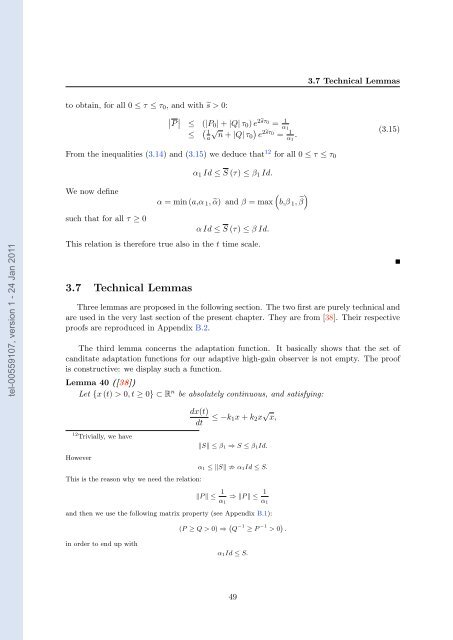Adaptative high-gain extended Kalman filter and applications
Adaptative high-gain extended Kalman filter and applications
Adaptative high-gain extended Kalman filter and applications
You also want an ePaper? Increase the reach of your titles
YUMPU automatically turns print PDFs into web optimized ePapers that Google loves.
tel-00559107, version 1 - 24 Jan 2011<br />
to obtain, for all 0 ≤ τ ≤ τ0, <strong>and</strong> with �s >0:<br />
�<br />
�P � � ≤ (|P0| + |Q| τ0) e2�sτ0 1 =<br />
≤ � 1<br />
a<br />
√ n + |Q| τ0<br />
� α1<br />
2�sτ0 1 e =<br />
From the inequalities (3.14) <strong>and</strong> (3.15) we deduce that 12 for all 0 ≤ τ ≤ τ0<br />
We now define<br />
such that for all τ ≥ 0<br />
α1 Id ≤ S (τ) ≤ β1 Id.<br />
α1 .<br />
�<br />
α = min (a,α 1, �α) <strong>and</strong> β = max b,β 1, � �<br />
β<br />
α Id ≤ S (τ) ≤ β Id.<br />
This relation is therefore true also in the t time scale.<br />
3.7 Technical Lemmas<br />
3.7 Technical Lemmas<br />
(3.15)<br />
Three lemmas are proposed in the following section. The two first are purely technical <strong>and</strong><br />
are used in the very last section of the present chapter. They are from [38]. Their respective<br />
proofs are reproduced in Appendix B.2.<br />
The third lemma concerns the adaptation function. It basically shows that the set of<br />
c<strong>and</strong>itate adaptation functions for our adaptive <strong>high</strong>-<strong>gain</strong> observer is not empty. The proof<br />
is constructive: we display such a function.<br />
Lemma 40 ([38])<br />
Let {x (t) > 0,t≥ 0} ⊂ R n be absolutely continuous, <strong>and</strong> satisfying:<br />
12 Trivially, we have<br />
However<br />
This is the reason why we need the relation:<br />
dx(t)<br />
dt ≤−k1x + k2x √ x,<br />
�S� ≤β1 ⇒ S ≤ β1Id.<br />
α1 ≤�S� � α1Id ≤ S.<br />
�P �≤ 1<br />
α1<br />
⇒�P �≤ 1<br />
<strong>and</strong> then we use the following matrix property (see Appendix B.1):<br />
in order to end up with<br />
α1<br />
(P ≥ Q>0) ⇒ � Q −1 ≥ P −1 > 0 � .<br />
α1Id ≤ S.<br />
49

















